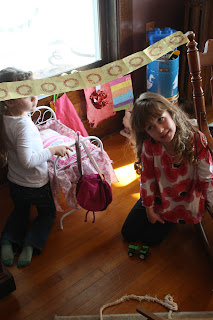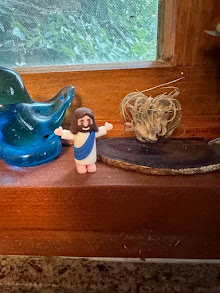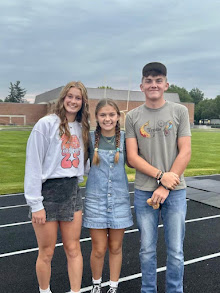It was cleaning the bathroom that did it. The downstairs bathroom, the one with a few leftover diapers in various sizes underneath the counter, the one with tear free kid's shampoo in the cabinet, the one with the rubbery dinosaur and frog from Target, the yellow duckie hand sponge, and the squirty fish toys that continued to bring squeals of surprise and laughter to baths as each grandchild came to visit and say, "I want to take a bath..."
It was just yesterday, I swear, that Aaron would climb up my back before his bath and ask for the "cups and spoons" out of my kitchen that stood in for 'real' bath toys before this grandma was quite prepared for water play. And here on my Timehop is a picture from five years ago...five years! with a little short Josh climbing out of his pants in an effort to join his older brother...a measuring cup in the picture... in the big iron tub just off the living room.
(It's an odd location for a bathroom, I concede, but closer to the family action and far warmer in the wintertime than than the one upstairs.) Josh doesn't ask for cups and spoons when he takes a bath anymore; Aaron is 13, and more likely to take a shower upstairs these days.when the kids come to stay. Levi still plays with the little boats and squishy fishes, but the time is coming when these toys will have done all their work and be as unnecessary as the diapers I should take to church so someone can use them.... What should I do with that handful of cheap little toys? Scoop them into a drawer? Into the trash? Will I be tidy? Or sentimental? I don't know. The squeaky frog toy my kids played with at my parents' still lives on the side of the tub.
This big, old, cluttered house doesn't lack for room for the toys of kids of all ages: the Gator, thirteen years old and now mute, but plenty sturdy for whichever kid, 4 to 9 chooses to skid it across the wood floor; the hardwood blocks in their wagon, made by my grandfather and well into their third generation of construction; a veritable artist studio of pencils and notepads, hole punches, stamps, and markers in the dining room at two short wooden play tables; dollies of various vintage that are still occasionally swaddled and left napping on the ottoman. The kids still dig through the big red barn toy box for defunct cell phones, handbags, and assorted construction toys, but there's no doubt the My Little Ponies, farm animals, and Toy Story characters are lonely for company these days...all but Buzz Lightyear!
Buzz, a handmedown from Gus via Lydia has captivated every small child in this house with his spinning aura of green and purple and astonishingly long battery life. Even Blake and I behold him with awe.
Thankfully, the front room is still awash with Legos...current Legos, five year old Legos, ten year old Legos....twenty year old Legos.........Legos a quarter century old! Legos: the past, the present, the happily ever after hand-me-down!
Despite the amusing meme and very real danger stepping on a Lego, it is a lucky grandma who finds random Lego creations lining the window sills and standing guard from the stairwell.
Periodically, when Levi calls to Facetime, he will ask if he can see the "toy room", and I walk through to reassure him that the train tracks and the farm machinery are as they were when last he saw them.
The day of Aaron's first junior high football game, Ann forwarded me a picture of Ben's seventh grade football picture. Ben has a big grin, wearing a big 75 on his red jersey. I guess he hadn't gotten the memo about looking grim and unsmiling in your sports shots. When I look at his picture, all I can think is, "Who pasted that little kid's head on that football body?"
Aaron's smiling sixth grade football pic on my fridge has been replaced by a squinting wary serious looking guy wearing the #30 Wolves jersey. No rookie photo mistakes for this seventh grader.
Years have passed between the junior high Indian and Wolf, and much has changed besides the uniform. But not the fun of climbing bleachers or making a road trip with other moms, dads, grandparents, friends...and assorted younger siblings and cousins.
Isn't there a song that says "Growing Up is Hard to Do"? NO...wait! That's "Breaking Up is Hard to Do" by Neil Sedaka....showing my age. It isn't always easy to pack away old toys or happy memories. So the bath toys stay at their posts, waiting to play with Joshie or Levi and I stick another piece of tape to keep the multi layered artwork on the door.
Yeah, and I'm better at Waylon and Willie than Neil Sedaka....
"She just talks about the good times they've had and all the good times to come"
--Waylon Jennings and Willie Nelson







































